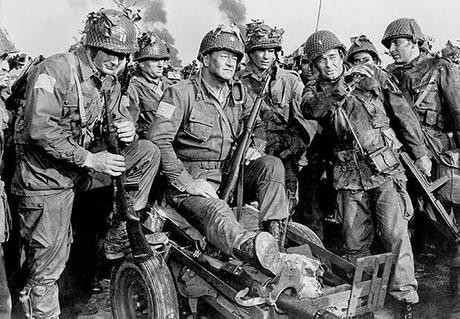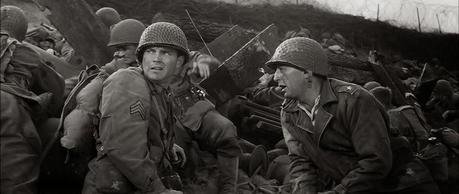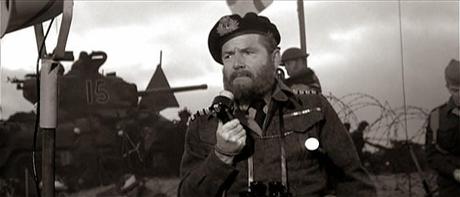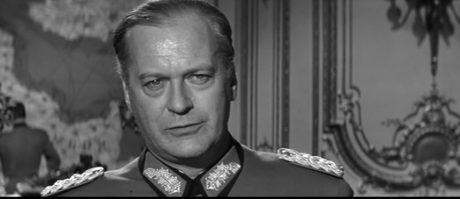 The Longest Day (1962) is the archetypical all-star war movie. Using a multinational cast of thousands, Daryl F. Zanuck recreates the June 6th, 1944 Normandy landings in meticulous detail. Perhaps too meticulous: the huge scope and tactical focus will impress military buffs more than casual viewers.
The Longest Day (1962) is the archetypical all-star war movie. Using a multinational cast of thousands, Daryl F. Zanuck recreates the June 6th, 1944 Normandy landings in meticulous detail. Perhaps too meticulous: the huge scope and tactical focus will impress military buffs more than casual viewers.June 1944 and the Western Allies prepare their major invasion. D-Day is set for June 6th, but Allied commanders fear bad weather will sabotage their plans. The Germans don't expect a Normandy landing, concentrating troops around Calais. As American, British and French troops go ashore, the story drifts among various units: Lieutenant Colonel Benjamin Vandervoort (John Wayne), leading spearheads of the 82nd Airborne; Brigadier General Norman Cota (Robert Mitchum), leading the Army Rangers on Omaha Beach; and assorted British and French detachments. In Paris and Berlin, the German high command scrambles to meet the "impossible" invasion.
The Longest Day was Zanuck's Hail Mary pass, redeeming his disastrous Cleopatra. Filming on location in France, Zanuck saved time and money splitting duties among directors: Ken Anakin handled the British sequences; Andrew Marton and Gerd Oswald the American moments and key action scenes; Bernhard Wicki (The Bridge) helmed the German segments. Author Cornelius Ryan and numerous military consultants were on-hand to ensure accuracy. Still a monumentally expensive show, its international success kept 20th Century Fox afloat.
The Longest Day's selling point remains the gobsmacking battle scenes. Annakin and his co-directors shoot huge recreations in black-and-white, lending a docudrama feel to this handsomely-mounted epic. There's no shortage of heart-stopping moments; the Allied fleet suddenly appearing through the mist, the tracking shot of American troops landing on Omaha Beach. Most impressive is the three-minute helicopter shot of French commandos liberating Ouistreham. A few scenes cheat with obvious stock footage, but the overall achievement can't fail to impress.
 Zanuck replicates Ryan's source book in painstaking detail. Allied generals fret over the weather, which has already scrubbed a previous attempt. General Eisenhower (Henry Grace) opts for June 6th, as it might be weeks before the next opportunity arises. Ground scenes focus on Allied efforts to maintain secrecy: the airborne troops using clickers to identify themselves, the British using exploding dummies used to distract the Germans. French resistance fighters and commandos play key roles, though strangely the Canadians at Juno Beach go unmentioned.
Zanuck replicates Ryan's source book in painstaking detail. Allied generals fret over the weather, which has already scrubbed a previous attempt. General Eisenhower (Henry Grace) opts for June 6th, as it might be weeks before the next opportunity arises. Ground scenes focus on Allied efforts to maintain secrecy: the airborne troops using clickers to identify themselves, the British using exploding dummies used to distract the Germans. French resistance fighters and commandos play key roles, though strangely the Canadians at Juno Beach go unmentioned.The invasion hits plenty of snags: many of the airdrops are ill-positioned (one detachment of the 82nd is massacred wholesale); Omaha Beach proves a grisly meat grinder; Army Rangers waste time and lives assaulting nonexistent guns at Pointe du Hoc. (This latter's only a partial truth, criticized by real veterans.) These elements bolster Zanuck's later claims that he intended Day as an antiwar statement. Yet Day is otherwise celebratory, lauding Allied heroism and closing on a rousing note.
Meanwhile, the Germans suffer from complacency and bad luck. Several commanders are away on war games exercises (or, in Erwin Rommel's case, visiting his wife), and their fighter planes have been re-staged, giving the Allies total dominance over the English Channel. One officer correctly outlines the Allied plan for his kriegspiel... then confidently predicts a landing at Calais. When Field Marshal Von Runstedt (Paul Hartmann) takes command, he can't utilize much-needed reserves: they're under Hitler's direct orders and the Fuhrer is asleep!
Day ultimately gets so caught up these details that it grows exhausting. Zanuck does a reasonably good job keeping the logistics clear, but it's dramatically clunky. The opening hour suffers particularly, with everyone from Vandervoort to Rommel portentously proclaiming the invasion's importance. Day expends its human moments on marginal players, like Jeffrey Hunter's scared sergeant or Richard Burton's harried RAF officer. Since these characters feature for all of 30 seconds, why bother? It's strange that Day came out the same year as Lawrence of Arabia, a much more human epic.
 Inevitably, The Longest Day has dozens of stars fighting for screen time. John Wayne naturally wins tough guy plaudits, leading airborne troops behind the lines with a broken ankle. Robert Mitchum earns honorable mention leading a suicidal assault on Omaha Beach. Red Buttons impresses as a paratrooper caught in the worst possible predicament. But Henry Fonda, Rod Steiger and Robert Ryan are so nondescript their roles could be played by anyone. Younger stars Jeffrey Hunter, Sal Mineo and Richard Beymer make zero impact.
Inevitably, The Longest Day has dozens of stars fighting for screen time. John Wayne naturally wins tough guy plaudits, leading airborne troops behind the lines with a broken ankle. Robert Mitchum earns honorable mention leading a suicidal assault on Omaha Beach. Red Buttons impresses as a paratrooper caught in the worst possible predicament. But Henry Fonda, Rod Steiger and Robert Ryan are so nondescript their roles could be played by anyone. Younger stars Jeffrey Hunter, Sal Mineo and Richard Beymer make zero impact.The British actors fare slightly better. Richard Burton's two brief scenes practically bookend the movie. Richard Todd (a real D-Day veteran) and Peter Lawford get fleeting acts of heroism before vanishing. Sean Connery and Norman Rossington have a fun doubles-act as cynical Scots. Kenneth More steals the show as a crusty officer directing traffic on Sword Beach. The French cast members - Arletty, Andre Bourvil (Le Cercle Rouge) and Christian Marquand (Lord Jim) among them - make little impression.
The German scenes are more dramatic than physical, giving their actors more to work with. Luftwaffe officer Heinz Reinecke gives The Duke a run for his money, strafing Sword Beach with just two planes. Curt Jurgens and Wolfgang Preiss (The Train) play mid-level generals who discover what's going on before their pigheaded commanders. Hans-Christian Blech (Decision Before Dawn) is an incredulous infantry commander and Gert Frobe a bumptious sergeant.
 All-star casts are always a double-edge sword. Casting John Wayne or Richard Burton in a role, however insubstantial, lends their characters familiarity - if nothing else, we'll recognize them later on. Unfortunately, Day (like many epics) uses this practice to avoid developing proper characters. They're personas rather than people, so who cares what happens? At least Day isn't as bad as The Greatest Story Ever Told (1965), with Wayne's infamous cameo as a Centurion.
All-star casts are always a double-edge sword. Casting John Wayne or Richard Burton in a role, however insubstantial, lends their characters familiarity - if nothing else, we'll recognize them later on. Unfortunately, Day (like many epics) uses this practice to avoid developing proper characters. They're personas rather than people, so who cares what happens? At least Day isn't as bad as The Greatest Story Ever Told (1965), with Wayne's infamous cameo as a Centurion.Certainly Day moved the war genre away from small-scale unit pictures to bloated, increasingly tedious epics. Annakin's follow-up, The Battle of the Bulge (1965), is an embarrassing cartoon. Tora! Tora! Tora! (1970) is good history but doesn't dramatically click until the Japanese planes take flight. Battle of Britain (1969) and Midway (1975) are snoozers mixing flag-waving and cheap melodrama. Another Cornelius Ryan book inspired the best, Richard Attenborough's A Bridge Too Far (1977). That movie suffers similar handicaps, but its "study in failure" structure proves a nice contrast to the usual heroics.
It's inevitable that The Longest Day works better in parts than as a whole. The scope and battle scenes still impress, even after decades of more graphic and "realistic" combat depictions. But for all its craftsmanship, Day lacks the intelligence and heart which mark the best war movies.

